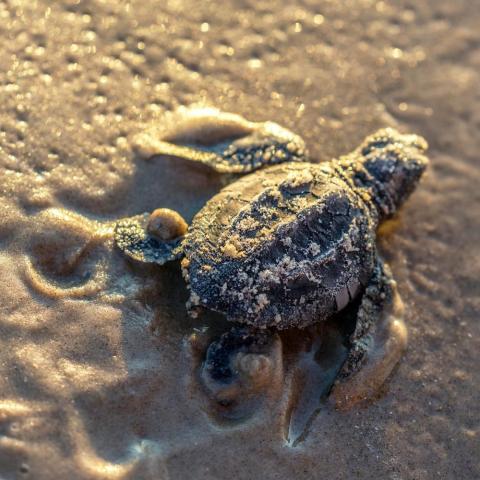
Kemp's ridley sea turtle hatchlings make their way across the beach at Padre Island National Seashore in Texas/NPS
Summer is sea turtle nesting season along the Atlantic and Gulf coasts, and national parks are a great place to catch a glimpse of these iconic sea creatures.
Most nests are laid in the early summer months, and although it varies by species, most eggs hatch 45 to 60 days later.
A few parks have special programs where you can learn more about sea turtles, or even watch mamas lumber ashore to lay their eggs at night or hatchlings make their way to the open water in the early morning.
Here are some sites where you're most likely to encounter nesting sea turtles or babies:
Cape Hatteras National Seashore
North Carolina is considered the extreme northern range for nesting sea turtles, with about 300 nests reported there last year, according to SeaTurtle.org, which monitors nests in the state. Loggerhead turtles are the most common species nesting at Cape Hatteras, but there are also occasionally green, leatherback, and Kemp's ridley turtles. The latter, unlike other sea turtles, nests during the day.
Visitors to the area are asked to report all sea turtle activity or sightings by calling (252)-216-6892.
Typically, Cape Hatteras offers the public a chance to watch sea turtle excavations in August and September. This is when scientists dig up a nest after it hatches to see what's left behind. They count the number of eggs hatched and collect other data, and sometimes find live hatchlings. Check their website for more information as the season progresses.
Cape Lookout National Seashore
Farther to the south in North Carolina, this park logged about 300 sea turtle nests last year. As in all areas, nests are marked and monitored throughout the season and morning beachgoers might glimpse of turtle tracks in the sand.
Cape Canaveral National Seashore
Located on Florida's Atlantic Coast, this is one of the most significant sea turtle nesting sites in the United States. As of May 25, more than 500 nests had already been counted along the seashore's 24 miles of pristine beaches. That included 488 laid by loggerheads and 19 by leatherbacks, the largest living sea turtle species weighing in at up to 2,000 pounds and measuring as long as 6 feet.
In an entire season, it's not unusual for there to be 5,000 to 10,000 nests here. Nearly 17,000 were logged in 2023, the most since records started being kept in 1984.
Cape Canaveral offers turtle walks on most Friday nights in June and July, leaving from either the north side of the park in Volusia County or the south side in Brevard County. There is no guarantee of seeing a turtle, but the experience is unique and educational either way. Spots fill up fast so it's best to make reservations early. Cost is $20 for adults and $1 for kids aged 8 to 15. Tickets can be purchased at recreation.gov.

A green sea turtle at Cape Canaveral National Seashore makes it back to the water. The sand covering her was evidence that she nested/NPS
Dry Tortugas National Park
This park spans seven small islands about 70 miles west of Key West, Florida, and is accessible only by boat or seaplane. Snorkelers and swimmers at Dry Tortugas may spot sea turtles in the water any time of year. During the summer, look for their tracks and marked nests in the sand. Campers at the park's Fort Jefferson might have a chance to catch a glimpse of nesting or hatching turtles at night.
Biscayne National Park
A few dozen sea turtle nests are typically observed at this South Florida site each year and park biologists mark and monitor them.
Gulf Islands National Seashore
The first turtle nest of the year was spotted on May 23 in a section of the park in the Florida Panhandle. Like all nesting areas, visitors to Gulf Islands are asked to keep their distance from turtles or hatchlings on the beach.
Padre Island National Seashore
Kemp's ridley turtles are more common here on the Texas Gulf Coast, and Padre Island park rangers and volunteers help make sure hatchlings get safe passage to the water. The public is invited to watch hatchling releases, which typically occur early in the morning from mid-June through August at Malaquite Beach, in front of the visitor center in Corpus Christi.
The park's website advises visitors to start checking in June for updates on this year's releases. Most are announced with little advance notice. Visitors can also check the Hatchling Hotline at (361) 949-7163.




 Support Essential Coverage of Essential Places
Support Essential Coverage of Essential Places






